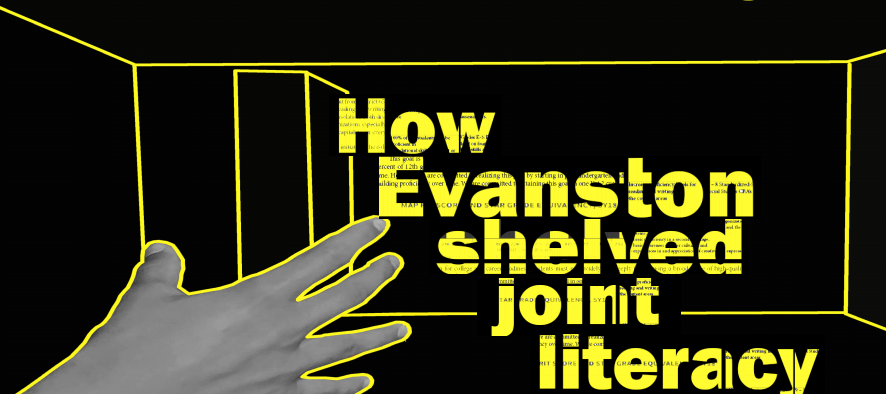How Evanston shelved joint literacy
May 23, 2019
The reading crisis
“I don’t know them. I haven’t met them, and I don’t know what they do.”
Nancy Odisho described that in her time as an ETHS reading teacher, she has never directly collaborated with another reading teacher from District 65.
60 percent of ETHS’ freshman class in 2018 began high school reading at grade level, according to a reading proficiency report presented by Scott Bramley, Associate Principal for Instruction and Literacy, and Kiwana Brown, the School-Wide Reading Specialist, at the Jan. 14 District 202 board meeting. This follows a trend of stagnant reading proficiency among incoming freshmen at ETHS over the last five years, as District 65 is seeing its students entering kindergarten less prepared for elementary school and leaving eighth grade less prepared for high school compared to three years ago, according to a 2018 Achievement and Accountability Report presented by Kylie Klein, District 65’s Director of Research, Accountability and Data, at the Jan. 28 District 65 board meeting.
“Five or six years ago, we were only talking about 50 students that we have to work with, and we can work with that,” said Assistant Superintendent and Principal Dr. Marcus Campbell. “But now it’s different, and it accumulates. 100 kids in this class, then another 100 kids in the next class; we have hundreds of kids.”
The magnitude of the problem has been increasing, but it shouldn’t come as a surprise. Back in 2014, districts 202 and 65 implemented the Joint Literacy Goal — a 12-year target of every ETHS student reading at grade level by the time they graduate — as a response to a growing achievement gap.
While both districts have addressed the lack of literacy progress individually, collaboration on reading supports and policies among the two districts’ administrators, reading teachers and school board members has been minimal.
“We don’t really have a strong knowledge of what the supports look like for their [District 65] students,” Brown, who was also a former ETHS reading teacher, said. “We need more time to actually be together to talk about things that are happening in both districts.”
Through data and curriculum discrepancies and a depleted sense of unified urgency, the two districts’ lack of partnership has allowed the reading crisis to steadily grow, despite the promise of collaboration established in the Joint Literacy Goal.
Separate worlds
The reading levels among ETHS freshmen have not gone unnoticed by administrators and reading teachers. In response to an ever-increasing number of students reading below grade-level, ETHS has implemented a myriad of policies to try to support students.
Recently, ETHS restructured intervention reading classes for ninth graders with flexible grouping for students who come in reading at the 25th percentile or lower on the MAP test, according to Brown. This has fostered individualized support that focuses on the growth of students in a six-week cycle where students then take a STAR assessment to gauge their progress. The intermittent testing helps determine which of the three levels of support the student may need.
“Our goal is to get them all to the top level before sophomore year because that’ll put them in a good position for sophomore year to go into Biology and into the earned honors Civics and English courses,” Brown said.
The earned honors system for Freshman Humanities classes was created as a way to avoid categorizing students’ academic abilities before their first day at ETHS. But the assistance for underperforming readers goes deeper than integrated classes.
“When we detracked, we put some kids with teachers who have training in reading,” said Campbell. “There are some earned honors classes that have more reading embedded in them. But you won’t find that by course code. You won’t find that on the transcript, but we know we’re offering more supports for these kids in this class.”
Within these earned honors supports, students who lie between the 28th and 54th percentile on MAP are placed in specific earned honors English and History courses where they receive an additional level of support from their English teacher, who also serves as their reading teacher.
“They know what they’re doing in class, but they also know what their needs are to be successful in the class, so the students get this extra level of intervention,” Brown said.
ETHS is clear in its pursuit of bringing up students’ reading performance, and it’s adapted to the rapidly increasing number of students who need additional support. Separately, District 65 has done the same by renewing focus on pre-k and kindergarten reading comprehension and developing new curriculum to engage students of color, according to a memo presented at a District 65 board meeting on April 22.
While the metrics remain at odds and the policies remain separate, Evanston teachers, families and students can’t reasonably expect the distressing trend of decreased literacy to reverse itself.
“Our teachers aren’t just sitting around waiting for metrics to measure our students’ reading. They’re doing their work,” former District 65 and District 202 board member Jonathan Baum said. “We just need to give them the framework to make their work as effective as possible.”
Lost in translation
While the school boards of Districts 202 and 65 frequently conduct joint meetings to discuss literacy goals, they’re still not on the same page in regards to reading assessment.
We [Slevin and Weglarz] reached out to three District 65 reading teachers, two District 65 administrators and three District 65 board members; all were unavailable to comment.
District 65 relies on the Measures of Academic Progress (MAP) test to gauge reading level, while ETHS uses the Standardized Test for the Assessment of Reading (STAR). Although they’re identical in intention, the two tests produce widely different results.
According to the January 2019 student achievement report, MAP testing reported that 84 percent of the 2018 freshman class is at grade level in reading. But the STAR assessment tells a different story, showing that the proportion was just below 60 percent. This fundamental disconnect between the two districts means that when attempting to address the problem of reading underperformance, the two districts don’t even have the same information about how serious the problem actually is. While they likely couldn’t have foreknown this dysfunction, ETHS administrators made a conscious decision to deviate from the unified assessment system recently.
“We’ve just started using STAR the past few years,” Campbell said. “We used the MAP, and we thought that it wasn’t working for reading. Now we think that STAR is more accurate for high school students. The story that STAR is telling us is the story that teachers are telling us they see happening in classrooms.”
The districts need to decide on a single metric so both school districts can develop more accurate benchmarks and a more effective policy. But in the four years since District 202 transitioned from MAP to STAR, no shared literacy projects have been initiated and the school boards are not closer to uniting their methods.
“You can say all you want about where kids are supposed to be in 12th grade,” said Baum. “But if you don’t have a way of measuring what the third or eighth grade equivalent is, then how are you going to get there?”
Lack of shared urgency
The metric mismatch between the two districts has been paralyzing to any attempt at a unified plan to combat decreasing literacy rates, slowing down the urgency of joint literacy efforts.
“We have enough data, and we can’t continue to talk about whether or not we’re using a consistent assessment tool or how do we use it,” District 202 board member Monique Parsons said. “We’ve been spending years having that conversation. What we know for sure is that regardless of which assessment is being used, our children are not reading at grade level.”
Parsons, like many former and current District 202 members, ran for re-election with the hope of reassessing the joint literacy goal between Districts 202 and 65.
“The only thing that has changed is that more students come into the district below grade level and we’re graduating them,” Parsons said. “Students are currently moving through the system not achieving the outcomes that we hoped, but we’re still talking about the different assessments.”
Reading underperformance in Evanston was first labeled as a “crisis” by the ETHS school board over three years ago, yet the number of students below grade level in reading has only increased, all while the two districts can’t even agree on the way they should measure reading levels.
Campbell maintained that District 202 is working closely with District 65 to help students achieve academic benchmarks, but the districts are yet to put forth a clear policy proposal involving both districts, and there haven’t even been any strides towards bolstering collaborations through reading teachers in the respective districts. “Collaboration could be bringing them here or us going there,” Odisho said. “Even an informal meeting would work, where we say, ‘hey, this is what our curriculum looks like and this is what we do.’”
The sense of urgency ascribed to each district is present, but the lack of collaborative urgency mitigates each district’s individual literacy programs. While there is still no publicized plan of action that would bridge teacher communication or collaboration across districts in the way that Odisho describes, both districts are centering students’ progress as readers in their initiatives.
“Because we are not making the strides we hoped for, we have to continue to reassess what we’ve done, what works, what hasn’t worked,” Parsons said. “I want to stop talking about the goal and assessments, and I want critical action in place and accountability to see that our students are progressing.”



















